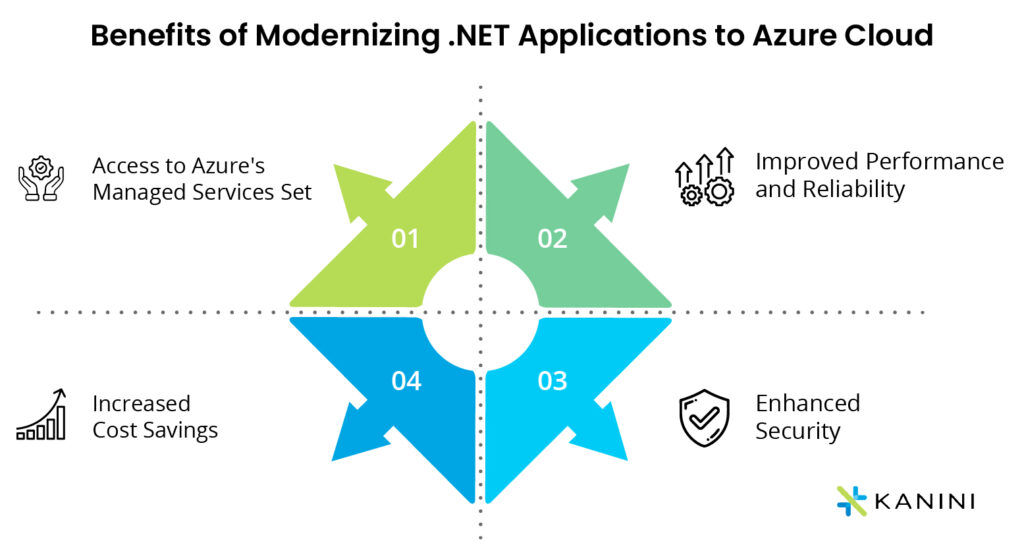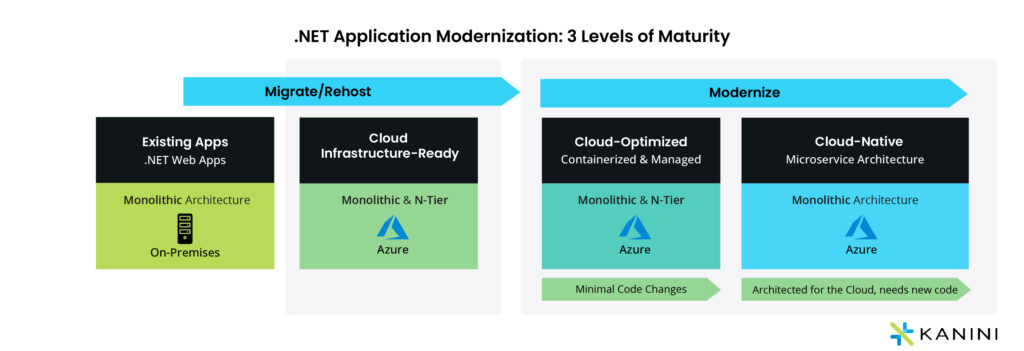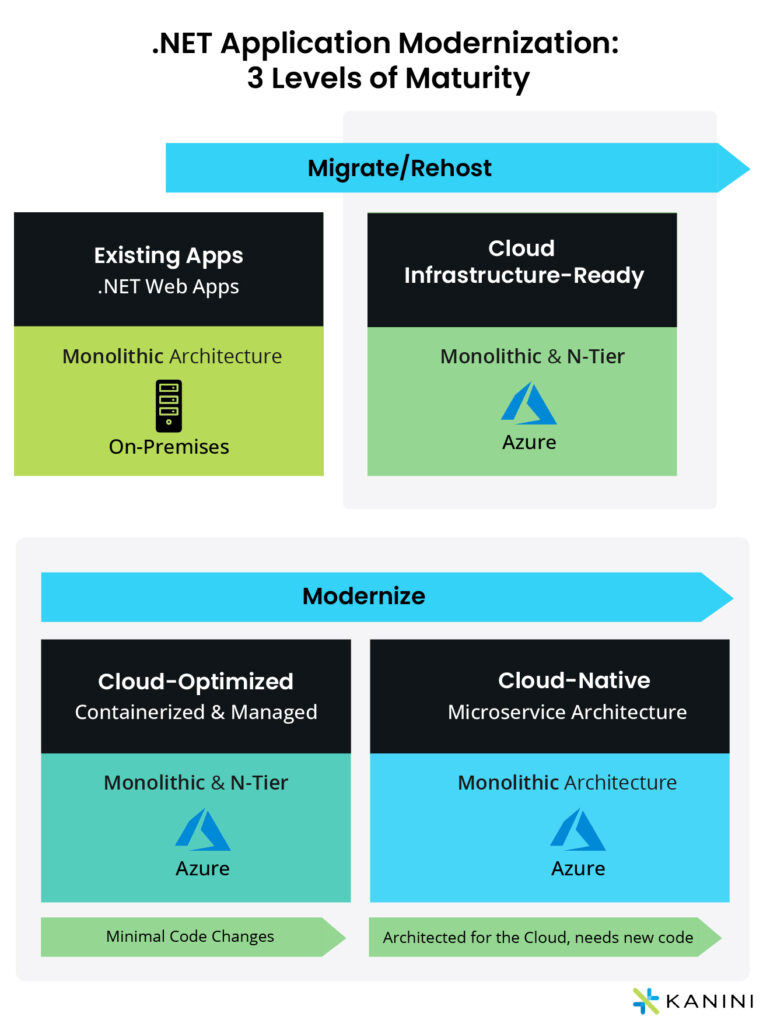Modernizing legacy .NET applications is the key to overcoming these challenges. .NET application modernization helps businesses improve operational efficiency, reduce maintenance costs, gain agility, enhance scalability, and stay ahead of the competition.
Beginning Your App Modernization Journey with Azure
Benefits of Modernizing .NET Applications to Azure Cloud

- Access to Azure’s Managed Services Set: One of the major benefits of modernizing .NET apps on Azure Cloud is that companies gain access to Azure’s extensive set of managed services, such as Azure App Service, Azure Functions, and Azure Kubernetes Service. These services help companies reduce operational overheads and focus on developing and delivering high-quality software products.
- Improved Performance and Reliability: Azure provides a robust and globally distributed network of data centers with high availability and fault tolerance. By modernizing .NET applications on Azure Cloud, companies can leverage this infrastructure to make significant improvements in application performance and reliability.
- Enhanced Security: Azure offers advanced security features that can help organizations strengthen their security systems. With Azure Cloud, companies gain access to security services such as Azure Key Vault, Azure Security Center, and Azure Active Directory, which help implement strong security controls and prevent threats.
- Increased Cost Savings: Modernizing .NET applications with Azure Cloud results in significant cost savings for companies. Azure has a pay-as-you-go pricing model that assists organizations in reducing their infrastructure costs by only paying for what they use. Azure also comes with cost optimization services like Azure Advisor and Azure Cost Management, which can be used by companies to reduce their Total Cost of Ownership (TCO).


- Cloud-Infrastructure Ready: This is the first level of modernizing existing legacy .NET applications to make them agile and compatible with current systems, particularly when businesses don’t intend to invest significant resources in the process. This approach won’t make legacy applications cloud-native, but it will help businesses obtain basic cloud benefits like agility, performance, and compatibility. At this level of maturity, a simple rehosting of existing on-premises .NET applications to an IaaS (Infrastructure as a Service) platform is done. The applications are deployed on virtual machines in the cloud – Microsoft Azure, with almost the same composition as before. This approach is known as the “lift and shift” method.
Rehosting can be achieved with Azure Migrate, a migration automation solution that offers valuable insights and mechanisms for migrating to Azure based on cloud tools like Azure Database Migration Service and Azure Site Recovery. - Cloud-Optimized: The next level comes into play when businesses need to reduce costs and improve the performance of existing .NET apps. This approach also ensures that the application infrastructure remains resilient and provides deeper insights into application performance. It simplifies deployments as well. At this level, by leveraging contemporary technologies such as cloud-managed services and containers, companies can run existing apps on the cloud without needing to rearchitect or refactor.
This process can be achieved using Windows containers, which are built on a Docker engine. Containers address the challenges posed by application dependencies during multi-stage deployment. Additionally, containers can be deployed as IaaS or PaaS (Platform as a Service), enabling companies to leverage various cloud-managed development practices such as using databases, implementing CI/CD (Continuous Integration/Continuous Deployment) pipelines, etc. This approach (usage of containers) enhances the agility of existing .NET applications, simplifying DevOps processes and speeding up delivery. Apps and their dependencies become highly portable, as they will be deployed to an Azure SQL Database Managed Instance. The most crucial step in this process is adding Windows Containers support to existing .NET applications without meddling with the code. Tools like Visual Studio can aid in creating a quicker path for containers to be deployed to Azure. In cases with more complex multi-container apps, companies can use orchestrators like AKS to streamline the process. - Cloud-Native: The next level in .NET application modernization is moving to cloud-native modernization. This involves migrating from the monolithic application architecture, on which most legacy .NET applications are built, to microservices architecture. For businesses requiring their applications to be built with better durability and scalability, this is the ideal approach. This method requires rearchitecting the applications for the cloud, and most of the time, the code must be entirely rewritten. This approach helps applications achieve the highest level of application maturity and makes them best suited for mission-critical use cases.
Due to the complexities involved in this rearchitecting approach, companies can use AKS, Azure Functions, and cloud PaaS tools for serverless integration to the cloud. Moreover, taking this approach requires rewriting the .NET framework code to adapt it to the specific PaaS platform and align it with the target microservices architecture.
Making the Right Choice
So, what are you waiting for? Reach out to us today to take the first step towards modernizing your .NET applications with Azure Cloud and making the best of this powerful platform.
Author

Robert Claypool
Robert is heading the Product Engineering Practice at KANINI. He has 16 years of experience in software development and spatial data analysis. Since 2012, Robert has been managing our Windows and Linux cloud infrastructure on AWS and Azure. And as the director of applications development, he oversees systems architecture, security, and DevOps practices across the organization.








